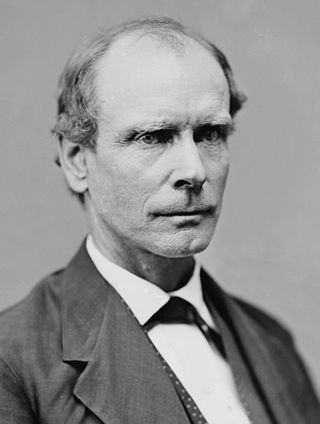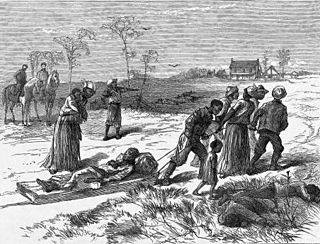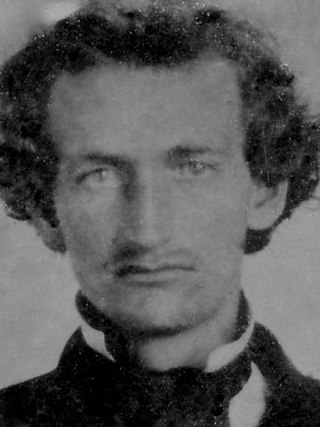
The Ku Klux Klan, commonly shortened to the KKK or the Klan, is the name of several historical and current American white supremacist, far-right terrorist organizations and hate groups. The Klan was "the first organized terror movement in American history." Their primary targets are African Americans, Hispanics, Jews, Latinos, Asian Americans, Native Americans, Italian Americans, Irish Americans, and Catholics, as well as immigrants, leftists, homosexuals, Muslims, atheists, and abortion providers.

The Reconstruction era was a period in United States history following the American Civil War, dominated by the legal, social, and political challenges of abolishing slavery and reintegrating the former Confederate States of America into the United States. During this period, three amendments were added to the United States Constitution to grant equal civil rights to the newly freed slaves.

Amos Tappan Akerman was an American politician who served as United States Attorney General under President Ulysses S. Grant from 1870 to 1871. A native of New Hampshire, Akerman graduated from Dartmouth College in 1842 and moved South, where he spent most of his career. He first worked as headmaster of a school in North Carolina and as a tutor in Georgia. Having become interested in law, Akerman studied and passed the bar in Georgia in 1850; where he and an associate set up a law practice. He also owned a farm and enslaved eleven people. When the American Civil War broke out in 1861, Akerman joined the Confederate Army, where he achieved the rank of colonel.
United States v. Cruikshank, 92 U.S. 542 (1876), was a landmark decision of the United States Supreme Court ruling that the U.S. Bill of Rights did not limit the power of private actors or state governments despite the adoption of the Fourteenth Amendment. It reversed the federal criminal convictions for the civil rights violations committed in aid of anti-Reconstruction murders. Decided during the Reconstruction Era, the case represented a major defeat for federal efforts to protect the civil rights of African Americans.

The Knights of the White Camelia was an American political terrorist organization that operated in the Southern United States in the late 19th century. Similar to and associated with the Ku Klux Klan, it supported White supremacy and opposed freedmen's rights.

The Colfax massacre, sometimes referred to as the Colfax riot, occurred on Easter Sunday, April 13, 1873, in Colfax, Louisiana, the parish seat of Grant Parish. An estimated 62–153 Black militia men were murdered while surrendering to a mob of former Confederate soldiers and members of the Ku Klux Klan. Three white men also died during the confrontation.
The Enforcement Acts were three bills that were passed by the United States Congress between 1870 and 1871. They were criminal codes that protected African Americans’ right to vote, to hold office, to serve on juries, and receive equal protection of laws. Passed under the presidency of Ulysses S. Grant, the laws also allowed the federal government to intervene when states did not act to protect these rights. The acts passed following the ratification of the Fourteenth Amendment to the US Constitution, which gave full citizenship to anyone born in the United States or freed slaves, and the Fifteenth Amendment, which banned racial discrimination in voting.
The Mississippi Plan of 1874 was developed by white Southern Democrats as part of the white insurgency during the Reconstruction Era in the Southern United States. It was devised by the Democratic Party in that state to overthrow the Republican Party in Mississippi by means of organized threats of violence and suppression or purchase of the black vote. Democrats wanted to regain political control of the legislature and governor's office. Their success in doing so led to similar plans being adopted by white Democrats in South Carolina and other majority-black states.

James M. Hinds was the first U.S. Congressman assassinated in office. He served as member of the United States House of Representatives for Arkansas from June 24, 1868 until his assassination by the Ku Klux Klan. Hinds, who was white, was an advocate of civil rights for black former slaves during the Reconstruction era following the American Civil War.
At the end of the American Civil War, the devastation and disruption in the state of Georgia were dramatic. Wartime damage, the inability to maintain a labor force without slavery, and miserable weather had a disastrous effect on agricultural production. The state's chief cash crop, cotton, fell from a high of more than 700,000 bales in 1860 to less than 50,000 in 1865, while harvests of corn and wheat were also meager. The state government subsidized construction of numerous new railroad lines. White farmers turned to cotton as a cash crop, often using commercial fertilizers to make up for the poor soils they owned. The coastal rice plantations never recovered from the war.
The Camilla massacre took place in Camilla, Georgia, on Saturday, September 19, 1868. African Americans had been given the right to vote in Georgia's 1868 state constitution, which had passed in April, and in the months that followed, whites across the state used violence to combat their newfound political strength, often through the newly founded Ku Klux Klan. Georgia agents of the Freedmen’s Bureau recorded 336 cases of murder or assault with intent to kill against freedmen from January 1 through November 15.
Crime rates in Alabama overall have declined by 17% since 2005. Trends in crime within Alabama have largely been driven by a reduction in property crime by 25%. There has been a small increase in the number of violent crimes since 2005, which has seen an increase of 9% In 2020, there were 511 violent crime offenses per 100,000 population. Alabama was ranked 44th in violent crime out of a total 50 states in the United States.

The Meridian race riot of 1871 was a race riot in Meridian, Mississippi in March 1871. It followed the arrest of freedmen accused of inciting riot in a downtown fire, and blacks' organizing for self-defense. Although the local Ku Klux Klan (KKK) chapter had attacked freedmen since the end of the Civil War, generally without punishment, the first local arrest under the 1870 act to suppress the Klan was of a freedman. This angered the black community. During the trial of black leaders, the presiding judge was shot in the courtroom, and a gunfight erupted that killed several people. In the ensuing mob violence, whites killed as many as 30 blacks over the next few days. Democrats drove the Republican mayor from office, and no person was charged or tried in the freedmen's deaths.

The Ku Klux Klan is an organization that expanded operations into Canada, based on the second Ku Klux Klan established in the United States in 1915. It operated as a fraternity, with chapters established in parts of Canada throughout the 1920s and early 1930s. The first registered provincial chapter was registered in Toronto in 1925 by two Americans and a Canadian. The organization was most successful in Saskatchewan, where it briefly influenced political activity and whose membership included a member of Parliament, Walter Davy Cowan.
Elias Hill was a Baptist minister and leader of a York County, South Carolina congregation that emigrated to Arthington, Liberia. In May 1871, during the Reconstruction era, he was among the victims in a series of attacks in York County against local blacks by members of the Ku Klux Klan. His situation received wide attention on account of his condition, as Hill had been stricken by an illness while a child which had left him crippled with his arms and legs in a withered state. He was known for preaching about rights and equality, and taught local children how to read and write.
Jim Williams was an African-American soldier and militia leader in the 1860s and 1870s in York County, South Carolina. He escaped slavery during the US Civil War and joined the Union Army. After the war, Williams led a black militia organization which sought to protect black rights in the area. In 1871, he was lynched and hung by members of the local Ku Klux Klan. As a result, a large group of local blacks immigrated to Liberia, West Africa.
On October 17, 1871, U.S. President Ulysses Grant declared nine South Carolina counties to be in active rebellion, and suspended habeas corpus. The order allowed federal troops, under the command of Major Lewis Merrill, to execute mass-arrests and begin the process of crushing the South Carolina Ku Klux Klan in federal court. Merrill reported 169 arrests in York County before January 1872. Numerous Klansmen fled the state, and more were quieted by fear of prosecution. Nearly 500 men surrendered to Merrill voluntarily, gave confessions or evidence, and were released. At the Fourth Federal Circuit Court session in Columbia, South Carolina beginning November 1871, United States District Attorney David T. Corbin and South Carolina Attorney General Daniel H. Chamberlain convicted 5 Klansmen in trial court, and secured convictions based on confession from 49 others. In the next Fourth Federal Circuit Court session in Charleston, South Carolina in April 1872, Corbin convicted 86 more Klansmen. Klan activities vanished while prosecutions were ongoing and publicized, but, by the end of 1872, federal will dissolved in the face of waning Republican support for Reconstruction. At the end of 1872 some 1,188 Enforcement Act cases remained to be tried. White Northern interests began to seek a more conciliatory relationship with Southern states, and lamented Southern papers' exaggerated tales of "bayonet rule." During the summer of 1873, President Grant announced a policy of clemency for those Klansmen who had not yet been tried, and pardon for those who had. The remaining cases were not tried, and prosecutions under the Enforcement Acts were all but abandoned after 1874.
Allen Pardee Huggins (1839–1916) was a Union Army soldier, Freedmen’s Bureau official, sheriff, county school superintendent, tax official, and state legislator in Mississippi.

The Vicksburg massacre, sometimes referred to as the Vicksburg riot, was a freedmen massacre on December 7, 1874 that continued until around January 5, 1875, in Vicksburg, Mississippi, U.S.. An estimated 150–300 Black citizens, and 2 White citizens were killed during the violence. Sheriff Peter Crosby, an African American, was forcibly removed from office, reinstated, and then shot in the head.

The First Klan is a neologism or retronym used to describe the first of three distinct operational eras of the Ku Klux Klan, a white supremacist domestic terrorist group of the United States. The First Klan, or Reconstruction Klan, was followed by the Second Klan, which had its peak in the 1920s, and finally by the Third Klan, extant since the 1960s. According to historian Carl Degler, "Aside from the name, about the only common trait that the three Klans possess is vigilantism."










